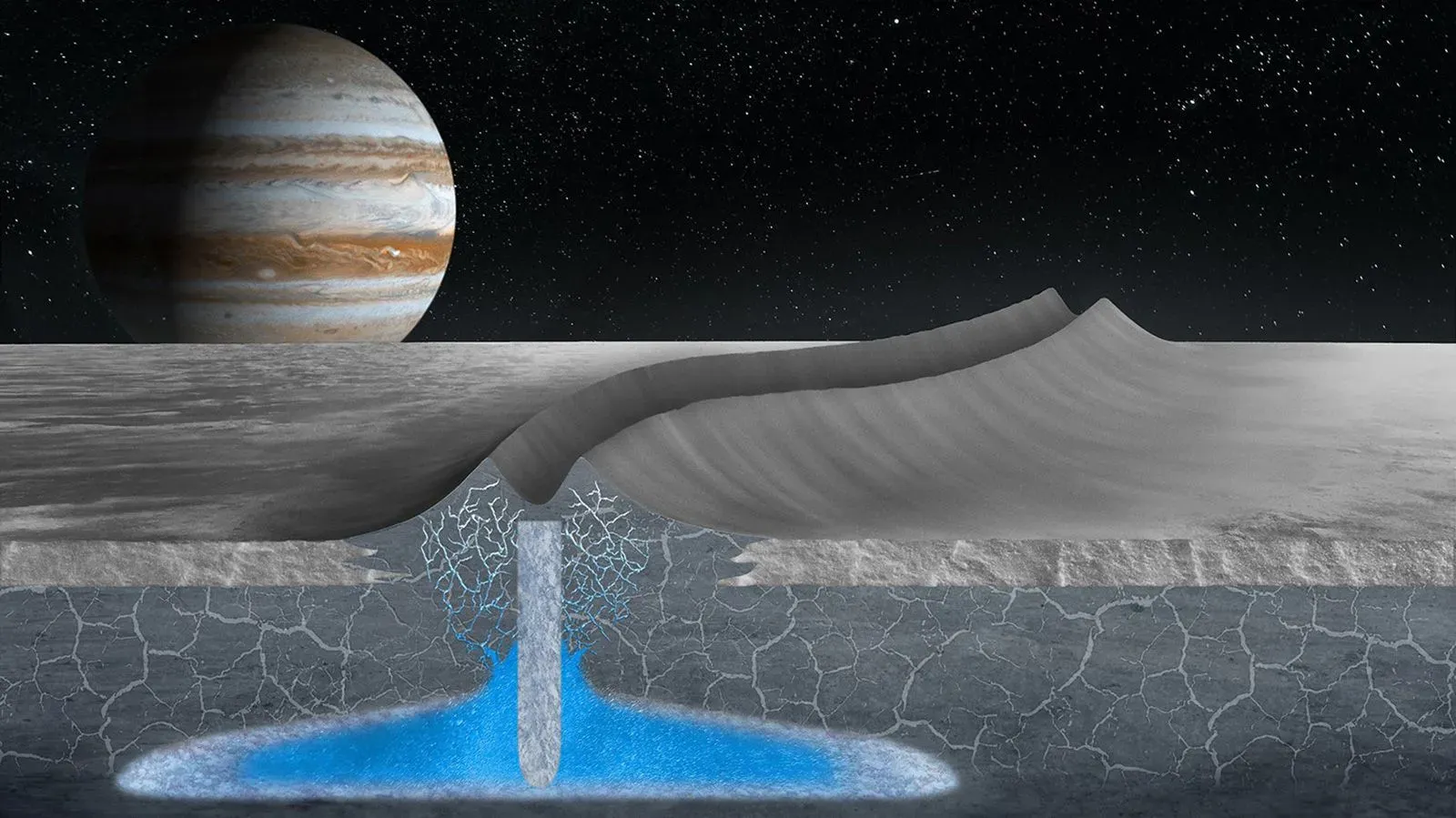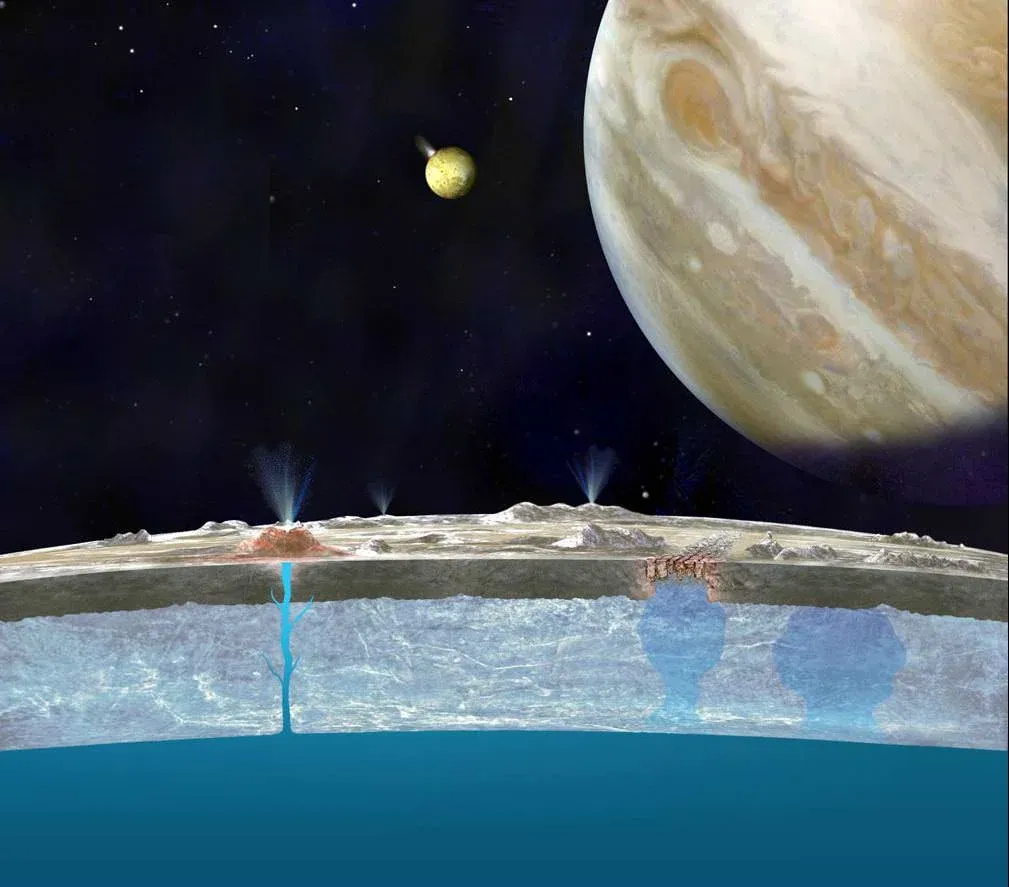Life on Europa: The Jupiter Moon That May Harbor a Habitable Ocean

The possibility of life on Europa has captivated scientists for decades, and recent discoveries have only deepened the mystery.
Anúncios
This moon, with its vast subsurface ocean, could be one of the most promising places in our solar system to search for signs of life.
As research continues, Europa’s potential is becoming clearer, prompting discussions about the implications of discovering life beyond our planet.
Such a discovery could revolutionize our understanding of biology and the conditions necessary for life to thrive.
Europa’s Icy Shell: A Window to a Hidden World
Europa, the sixth-closest moon to Jupiter, is slightly smaller than Earth’s moon but boasts a surface that is strikingly different.
Covered in a thick layer of ice, its cracked and ridged exterior hints at a dynamic world beneath.
Scientists believe this icy shell, which could be several kilometers thick, conceals a global ocean that may hold more than twice the volume of all Earth’s oceans combined.
What makes this ocean so compelling is the potential for it to be habitable.
On Earth, life thrives in the most extreme environments—deep-sea hydrothermal vents, acidic hot springs, and even beneath Antarctic ice.
If life can exist in such harsh conditions here, why not on Europa?
The moon’s ocean is thought to be in contact with a rocky seafloor, creating the possibility of chemical reactions that could support microbial life.
Additionally, the study of extremophiles on Earth helps scientists understand the potential for life in similar environments elsewhere.
By examining how life adapts to extreme conditions, researchers can better assess Europa’s habitability.
The Clues Beneath the Ice
One of the most tantalizing clues about life on Europa comes from the Hubble Space Telescope.
In 2013, it detected plumes of water vapor erupting from the moon’s south pole, suggesting that the ocean beneath the ice might occasionally vent into space.
These plumes could provide a direct way to sample Europa’s ocean without drilling through miles of ice.
NASA’s upcoming Europa Clipper mission, set to launch in the 2020s, aims to explore these plumes and analyze their composition.
Equipped with advanced instruments, the spacecraft will map the moon’s surface, measure the thickness of its ice shell, and search for organic molecules—key ingredients for life.
This mission will also investigate the moon’s surface chemistry, potentially revealing more about the ocean’s characteristics.
By understanding the materials present on the surface, scientists can infer the ocean’s composition and its potential for supporting life.
+ Life in the Clouds of Venus: Scientists Detect Possible Biological Signs
A Habitable Environment?
The idea of life on Europa hinges on three critical factors: liquid water, essential chemical elements, and a source of energy.
Europa seems to check all these boxes.
Its ocean is likely salty, similar to Earth’s oceans, and contains elements like carbon, hydrogen, nitrogen, oxygen, phosphorus, and sulfur—essential building blocks for life as we know it.
But what about energy?
Sunlight doesn’t penetrate Europa’s icy shell, so photosynthesis is off the table.
Instead, life might rely on chemosynthesis, a process used by some Earth organisms that convert chemical energy from hydrothermal vents into food.
Europa’s rocky seafloor could host similar vents, providing the necessary energy for microbial communities.
Moreover, the potential for hydrothermal activity increases the likelihood of a stable environment conducive to life.
If such vents exist, they could create rich ecosystems similar to those found in Earth’s deep oceans, where life flourishes despite extreme conditions.

The Role of Tidal Forces
Jupiter’s immense gravitational pull creates tidal forces that flex Europa’s interior, generating heat through friction.
This heat could keep the ocean liquid and drive geological activity, much like the way Earth’s core generates heat.
These tidal forces might also create cracks in the ice, allowing nutrients and chemicals to circulate between the surface and the ocean below.
This dynamic environment raises intriguing questions.
Could these tidal forces also create stable habitats for life?
And if so, how complex could that life be?
While microbial life seems the most plausible, some scientists speculate that more complex organisms could exist, especially if Europa’s ocean has been stable for billions of years.
Understanding the geological processes at play on Europa will be crucial in determining the moon’s habitability.
Investigating these processes could reveal how nutrients are cycled and how life might adapt to the unique conditions of Europa’s ocean.
Challenges to Overcome
Despite the promising signs, confirming life on Europa is no easy task.
The moon’s surface is bombarded by intense radiation from Jupiter’s magnetic field, making it a hostile environment for both life and spacecraft.
Any mission to Europa must navigate these challenges while searching for definitive evidence of habitability.
Moreover, drilling through the ice to reach the ocean remains a significant technical hurdle.
While robotic probes and submersibles are being developed for this purpose, such a mission is likely decades away.
In the meantime, scientists must rely on indirect methods, such as analyzing surface ice and plumes, to piece together the story of Europa’s hidden ocean.
Advancements in technology may help overcome these obstacles, with new materials and designs for spacecraft being explored.
These innovations could enhance the resilience of missions, allowing them to withstand Europa’s harsh conditions while gathering vital data.
++ Could Enceladus Have Life? Saturn’s Moon Intrigues Scientists
Europa vs. Other Ocean Worlds
Europa isn’t the only moon in our solar system with a subsurface ocean.
Enceladus, a moon of Saturn, also has plumes of water vapor and a potentially habitable ocean.
However, Europa’s ocean is larger and may have been stable for a longer period, increasing the chances of life evolving there.
To compare these two ocean worlds, let’s look at some key data:
| Feature | Europa | Enceladus |
|---|---|---|
| Ocean Size | 2-3 times Earth’s oceans | Smaller than Earth’s oceans |
| Surface Temperature | -160°C (-260°F) | -200°C (-330°F) |
| Plume Activity | Occasional | Frequent |
| Radiation Levels | Extremely high | Moderate |
While Enceladus is easier to study due to its frequent plumes, Europa’s larger ocean and potential for long-term habitability make it a prime target for astrobiological research.
Additionally, studying both moons can provide insights into the conditions necessary for life in extreme environments.
Comparative analysis of these ocean worlds will enhance our understanding of where to focus future exploration efforts.

The Ethical Implications
The search for life on Europa also raises ethical questions.
If we discover life, how should we proceed?
Contamination from Earth could jeopardize any native organisms, and vice versa.
Strict planetary protection protocols are in place to prevent contamination, but the stakes are high.
Moreover, finding life on Europa would fundamentally change our understanding of biology and our place in the universe.
It would suggest that life is not a rare fluke but a common phenomenon, potentially existing wherever the right conditions are met.
This realization could lead to profound philosophical and ethical discussions about humanity’s responsibilities in the cosmos.
As we explore other worlds, it’s crucial to consider the implications of our actions and the potential impact on extraterrestrial ecosystems.
What’s Next?
The Europa Clipper mission represents the next major step in exploring this enigmatic moon.
By analyzing its surface and plumes, scientists hope to gather enough evidence to determine whether Europa’s ocean is indeed habitable.
If the results are promising, a follow-up mission to drill through the ice and explore the ocean directly could be on the horizon.
In the meantime, advancements in technology and our understanding of extremophiles on Earth continue to inform the search for life on Europa.
Each new discovery brings us closer to answering one of humanity’s most profound questions: Are we alone in the universe?
The ongoing exploration of Europa is not just an academic pursuit; it’s a quest that could redefine our understanding of life itself.
For more information on Europa and upcoming missions, visit NASA’s Europa Clipper page.
Conclusion
Europa, with its hidden ocean and potential for habitability, stands as one of the most exciting frontiers in the search for extraterrestrial life.
While many challenges remain, the possibility of life on Europa continues to inspire scientists and dreamers alike.
As we prepare to explore this distant moon, we may be on the brink of a discovery that reshapes our understanding of life itself.
The journey to Europa is not just a scientific endeavor—it’s a quest to uncover the mysteries of our cosmic neighborhood and, perhaps, to find our place among the stars.
